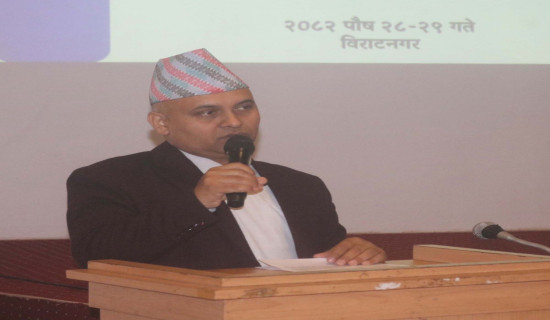- Friday, 16 January 2026
Dawn Of Renewable Energy
Amid doom and gloom surrounding climate change and its ravages, one glimmer of hope has emerged on the horizon: the dawn of the renewable energy era. The world is increasingly ditching fossil fuels in favour of renewable sources of energy, such as solar, wind, hydro, and geothermal power, to satiate its growing energy needs. This transition is fuelled by the urgency to reduce greenhouse gas emissions, combat climate change, and create a sustainable and resilient energy system. Also driving the transition are falling prices of and technological advancement in materials (primarily solar panels and wind turbines) used to harness renewable energy, making them more efficient and affordable, as well as recent geopolitical tensions that called for energy security. And it is solar energy that is turbocharging this remarkable boom.
Profound shift
In fact, this profound shift has been so dramatic that it has even surprised the experts closely tracking the trend. Today in much of the developed world, cars and buses, cranes, and private and municipal buildings, among many other things, are increasingly being powered by electricity from solar, wind, or other sources of clean energy. Renewables are now forecast to surpass coal, one of the dirtiest yet most widely consumed fossil fuels the world over, by 2025 as the world’s largest source of electricity. Governments worldwide are heavily investing in clean energy projects as part of their decarbonisation effort. Private investments have also skyrocketed. The costs of solar and wind power have been falling fast and, in many places, have become cheaper than gas, oil, or coal.
Only a decade and a half ago, solar panels, wind turbines, and battery-powered vehicles were seen as too expensive and ill-suited for mainstream use. But to everyone’s surprise, the cost of solar power has now dropped by over 80 per cent, and that of wind power by over 50 per cent. Similarly, the price of a lithium-ion battery, needed to store the generated power for subsequent use, has plunged by over 95 per cent over the course of the past three decades. In one of its May 2024 news reports, the AP wrote that 2023 was a record-breaking year for renewable energy sources. For the first time, 30 per cent of electricity produced worldwide was from clean energy sources, with solar making up the biggest share. And China was leading the trend, accounting for 51 per cent of the new solar power and 60 per cent of the new wind power globally. What’s more, more than twice as much solar power was added as coal power—a trend that is expected to grow even stronger in the future. That year also saw the global investors pouring more money into solar power—USD around 380 billion, according to the New York Times—than into drilling for oil.
Besides economic and altruistic reasons, geopolitical tensions are steering this trend. Months into the Russia-Ukraine war that broke out in early 2022, when Russia turned off the supply of its cheap gas to Europe in response to its staunch support for Ukraine, the implications for the continent were stark: Energy prices went through the roof, jumping as much as 15-fold in some European countries and triggering the cost-of-living crisis. Even the most powerful of the economies, like those of the UK and Germany, were left teetering on the edge of recession. Shaken by this painfully shocking new reality out of complacency that also laid bare its heavy reliance on Russian gas, and in an effort to wean themselves off it and to achieve energy security, the countries have taken to building infrastructure to generate renewable energy. In the United States (US), laws enacted by President Joe Biden that earmarked USD 1 trillion for clean energy—to enhance the power grid, buy electric vehicles for schools, and build their charging infrastructure—have hastened the transition.
Challenges
The shift towards renewable energy seems unstoppable and is poised to provide half of the world’s electricity by 2030, reckons the International Energy Agency, the global energy watchdog—a fact evidenced by the explosive growth of electric vehicles (EVs). In 2020, one in 25 cars sold globally was electric. That figure jumped to one in five in 2023. At the same time, it has warned that that is not enough to prevent the temperature from crossing the key threshold of 1.5 °C. Oil and gas companies are jacking up their lobby to block or stall the state support for clean energy like EVs and solar panels, and at times they have been successful.
There are also impediments to their widespread adoption. Solar energy is available when the sun shines, and wind power is abundant only during windy days. This intermittent nature has precluded people from getting rid of fossil fuels. There are two more challenges. First is storage. Storing the generated energy requires eye-popping investment, and for many countries like Nepal, that is not a viable option. Installation of storage systems is failing to keep up with the energy generation. But there are signs that this will no longer be the bottleneck in the near future as investment in storage plays catch up. Second is cost. The initial investment cost of renewable energy technologies is still high, though rapidly falling, requiring significant financial resources for infrastructure development and upgrades.
Nonetheless, the future of renewable energy looks promising as countries and companies set ambitious climate goals. Continued advancements in technology, coupled with supportive policies and increased public awareness, are sure to accelerate the transition to clean energy. Governments worldwide are implementing policies and incentives to support renewable energy adoption, such as subsidies, tax credits, and renewable mandates. In the case of Nepal, the need to switch to renewable has never been more urgent. Abundant with sunny days and windy places, Nepal is in a good position to leverage these strengths and wean itself off costly fossil fuels.
(Basyal works as a journalist at The Rising Nepal.)






-original-thumb.jpg)










